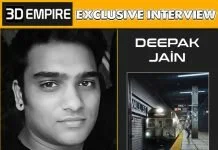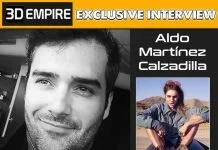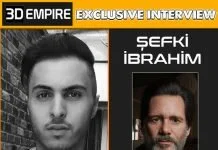3DE – First of all; we thank you for accepting this interview with us. Will you please shortly introduce yourself?
Hello and thank you so much for having me! My name is Lucia Frascerra and I am an Architectural Visualizer currently working as Senior Visualisation Artist at Smith in London.
3DE – When and how did you begin to deal with 3d art?
I studied Architecture in Florence and I soon realized that in order to get good grades I had to showcase very well my projects. That’s where I started to get interested in 3D art and here is where my journey began.
3DE – Did you improve your 3d knowledge by online tutorials-books or did you ever take an 3d course?
At the very beginning I started using Archicad and sketchup but I soon switch to Rhinoceros for modelling and Artlantis for rendering. So far I’ve been self teaching, trying to figure out how to use the software without much external help. The problem was that my knowledge was not really very advanced and I didn’t know how to texture my model in 3d! This is why I started to heavily rely on photoshop to add colours and materials in postproduction. I didn’t know much photoshop either, but I found the holy Graal in Alex Hogrefe’s blog “Visualizing Architecture” where I could find exactly the type of photoshop tutorials I needed to go from a very basic raw render to a fairly advanced final image completed with textures, people, sky, atmosphere, etc. For a while I kept operating with this workflow, but at some point I realized that it was probably not enough if I wanted to turn this passion into a real job. For this reason I decided to attend a private course in computer graphics which really opened for me the doors of architectural visualization.
3DE – Which softwares do you use?
I use 3DS Max, Vray, Corona and Photoshop
3DE – What kind of workflow do you follow during the creation of a scene of yours?
I normally start with a pretty vague idea of what I want to do and I start collecting references until the idea becomes more defined. at that point I usually make a quick sketch to make sure I get the composition right. Once I’m happy with it, I go ahead into the 3d software and I recreate the composition of the sketch and I try to follow the selected references in terms of colours and mood. Once the render is done, a very important part of my workflow is postproduction in photoshop where I really feel like I can express myself with adding details and atmosphere.
3DE – What are your motivations while working on a new scene?
It depends, but when I do a personal image I very often do it for a competition, which means that my motivation is trying to win!
3DE – Do you ever loose your motivation and passion of 3d sometimes? If you do, how do you deal with it and get back into your mood?
I don’t think I’ve ever lost my passion, but I definitely had creative blocks many times, where my mind went blank and I couldn’t find inspiration in anything. This could be incredibly frustrating but I’m sure that it’s a very common issue for people who work in creative industries and I’m not the only one suffering from it. I found that these periods could be either short or long but at some point the inspiration comes back, and most of the time it’s stronger than before!
3DE – When we check your works; we see that you mostly deal with concept-themed scenes instead of average usual interior or exterior renders. Is there a special reason for this?
Yes there is actually – I really enjoy working around deep concepts and stories, I find it very rewarding when I manage to communicate a very specific emotion with my images and I believe this is why I operate this way. I loved working on the production on “Before you go” and “Harbor” for example – they were both produced to be the posters for theatre plays and I guess it is a pretty unusual commission for an architectural visualizer.
-What kind of difficulties do you meet in your business sector of interior design regarding 3d art?
I guess the biggest difficulty I encountered in my career was trying to make sure the client understood that what we as a company do, is not only very valuable, but also a real form of art and they should trust our judgment.
Clients most of the times think differently from us: for example, they very often want to see as much as possible in a single shot and it’s hard to convince them that the view will not benefit from a 14mm lens camera! I guess it’s all up to us to make sure clients know what to expect and when to expect it, we need to be the ones in control of the process, not them. I think this is the most tricky aspect of the job to me.
3DE – Which one is more important to you; Making an artistic render or Making a render in least time possible to present to the client?
Without any doubt, making a piece of art is the first priority to me. Of course it’s essential that the deadline is met, but the deadline should be discussed between us and the client before starting to work on the project. This will ensure we know how much time we have at our disposal and how many people can work on that project at that specific time. If the time is not enough or if we don’t have enough resources to produce a beautiful artwork we might decide to turn down the job or agree with the client on less or none rounds of comments.
3DE – Which one is more important? The software or the talent of the artist who uses that software?
There is no doubt that the talent is more important to me – software alone is not remotely enough to do this job. This doesn’t mean that talent and no knowledge of software is enough either. In a day to day job, it’s also very important to learn how to efficiently use the software (it doesn’t really matter the ones you choose) because software are tools of our trade and without tools we can’t really meet deadlines! It’s true though that talend can’t really be taught, it’s something a person either has by nature or acquires with time and experience, but software can be learned regardless of how talented a person is.
-What are your advices to newbies?
My advice for people who want to start or have just started in this industry is try not to be obsessed by the software and try not to rush things as it’s perfectly fine to need time to progress in the right direction.
Spend some time on Pinterest and get inspired by photographers and other artists and try to understand why you like an image but dislike another – this helped me a lot at the beginning to understand my personal taste. Learn composition and colour theory as if you get them right 60% of your image is already done. And most of all, enjoy the process!
A really big thank you to Inan Arslan for asking me to do this interview!
If you want to check out some of my work you can find me here:
Instagram: lucia_frascerra
Facebook: Lucia Frascerra Visualization
Web: https://www.luciafrascerra.com/
CGarchitect: https://www.cgarchitect.com/members/luciafrascerra







